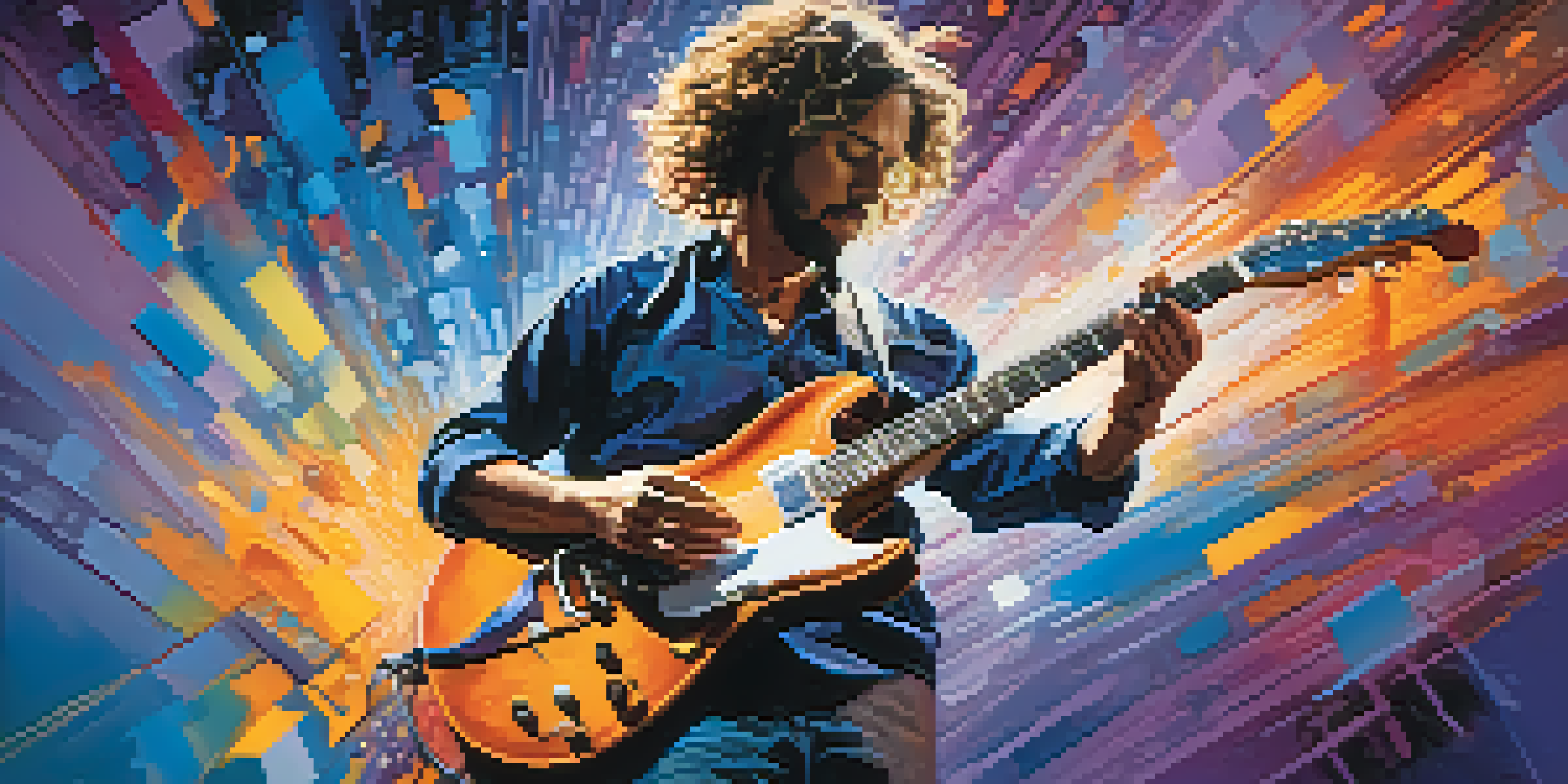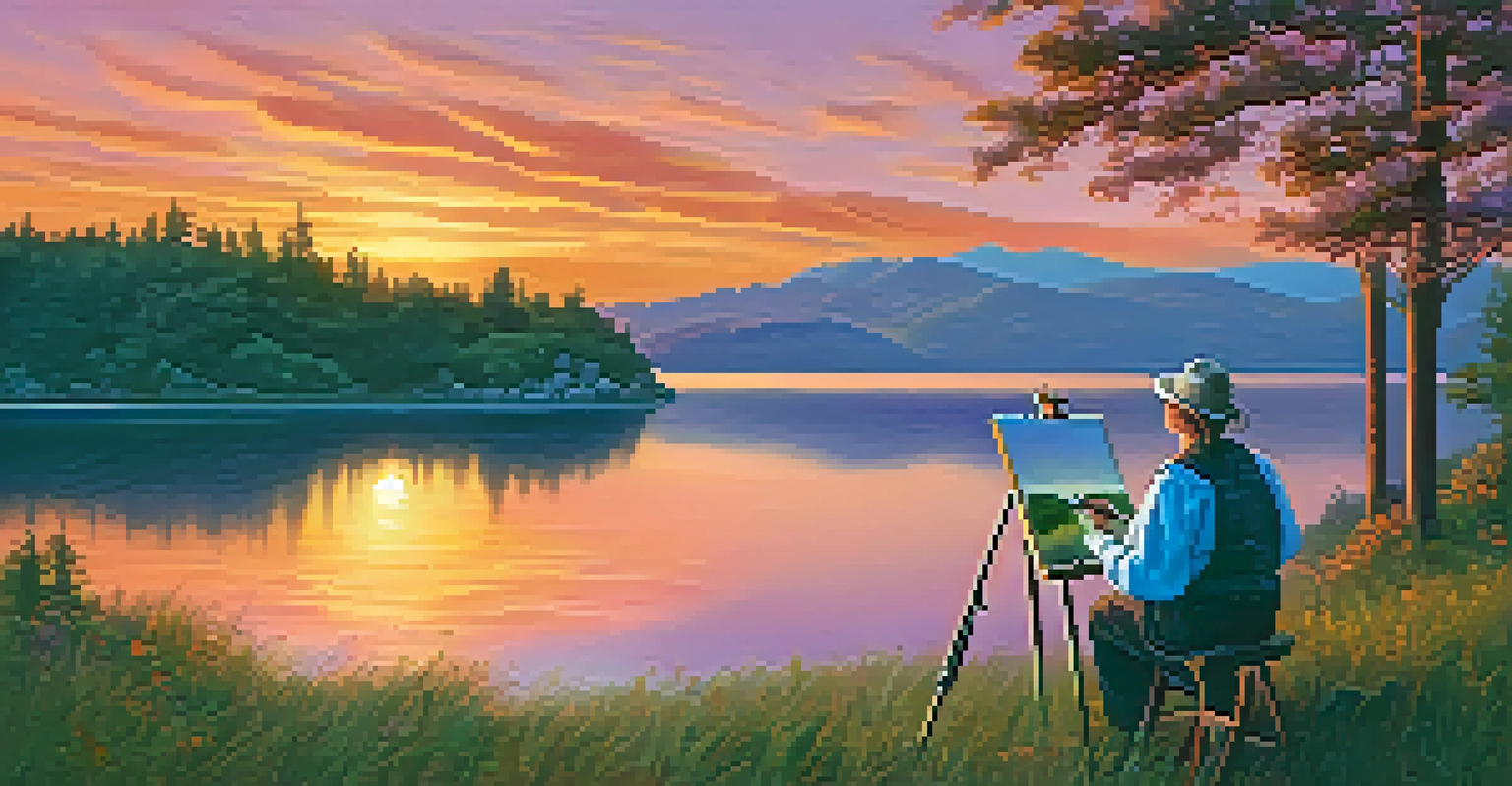The Power of Collaboration: Guitarists and Visual Artists Unite

The Joy of Creative Synergy in Art and Music
Collaboration between guitarists and visual artists creates an exciting fusion of creativity. When these two forms of art come together, they resonate on a deeper level, capturing emotions that words alone can't express. Just as a guitarist finds inspiration in melodies, a visual artist draws from colors and shapes, and combining these elements can lead to stunning results.
Creativity is thinking up new things. Innovation is doing new things.
Think of it like a dance; each artist has their own rhythm and style, but when they move together, they create something beautiful. For instance, a guitarist might compose a piece inspired by a painting, while the visual artist interprets that music into a visual form. This back-and-forth not only enhances their individual works but also creates a narrative that engages audiences in a unique way.
Ultimately, this synergy encourages both artists to step outside their comfort zones, exploring new ideas and techniques. The result is a fresh and dynamic art experience that can captivate fans of both disciplines. It’s a reminder that collaboration can lead to extraordinary creativity that transcends traditional boundaries.
Historical Examples of Artistic Collaborations
Throughout history, there have been iconic partnerships between musicians and visual artists that showcase the power of collaboration. A notable example is the collaboration between the legendary guitarist Jimi Hendrix and artist Jim Marshall, whose stunning photographs captured the essence of the 1960s music scene. Their work together not only defined an era but also influenced countless artists that followed.

Another famous pairing is the relationship between The Beatles and artist Peter Blake, who designed the album cover for 'Sgt. Pepper's Lonely Hearts Club Band.' This vibrant artwork reflects the innovative spirit of the music, and the collaboration remains one of the most recognized in music history. Such partnerships highlight how visual art can enhance and amplify the emotional impact of music.
Collaboration Fuels Creative Growth
Working together allows artists to explore new ideas and techniques, enriching their individual crafts.
These historical examples remind us that collaboration is not a new concept; it has been shaping the arts for centuries. Each partnership is a testament to the belief that creativity thrives on shared ideas and mutual inspiration, paving the way for future collaborations across various artistic mediums.
Modern Collaborations: A New Wave of Creativity
In today's digital age, collaborations between guitarists and visual artists have taken on new forms thanks to technology. Social media platforms allow artists from different backgrounds to connect and share their work with a global audience. This has led to innovative projects where music videos become canvases for animation and visual storytelling.
Great things in business are never done by one person; they're done by a team of people.
For instance, many musicians are now commissioning visual artists to create stunning visuals that accompany their music, whether in music videos or live performances. This integration not only enhances the viewer's experience but also offers a fresh perspective on how music and visuals can work together. It’s like watching a story unfold, where each note complements the art on screen.
Moreover, platforms like Instagram and TikTok have provided a stage for emerging artists to collaborate in real-time, producing captivating content that resonates with their followers. This modern approach to collaboration encourages experimentation and pushes the boundaries of traditional art forms, making it an exciting time for both musicians and visual artists alike.
The Role of Technology in Artistic Collaboration
Technology plays a crucial role in facilitating collaboration between guitarists and visual artists. With tools like digital audio workstations and graphic design software, artists can easily share ideas and co-create without geographical limitations. This accessibility allows for a diverse range of influences and styles to merge, resulting in innovative artistic expressions.
For instance, virtual reality (VR) and augmented reality (AR) are emerging as exciting platforms for collaborations. Imagine a guitarist performing in a virtual space where visual artists create live illustrations based on the music. Such immersive experiences not only engage audiences in new ways but also challenge the conventional boundaries of art and performance.
Technology Enhances Artistic Synergy
Advancements in technology facilitate seamless collaboration between guitarists and visual artists, leading to innovative projects.
Additionally, online collaborative platforms enable artists to work together seamlessly, sharing files and concepts in real-time. This ease of communication fosters a culture of creativity and experimentation, encouraging artists to push the envelope and explore uncharted territories in their collaborations.
Benefits of Collaboration for Artists
Collaborating with other artists offers numerous benefits, including exposure to new ideas and techniques. For guitarists, working with visual artists can inspire new musical directions, while visual artists might find fresh perspectives in the rhythms and emotions conveyed through music. This mutual exchange enriches both parties, allowing them to grow and develop their craft.
Moreover, collaborations can lead to increased visibility for both artists. When a guitarist teams up with a visual artist, they tap into each other's fan bases, expanding their reach and attracting new audiences. This cross-pollination of followers can lead to exciting opportunities for future projects, performances, and exhibitions.
Finally, collaboration fosters a sense of community among artists. By sharing their experiences and learning from one another, they create lasting bonds that can lead to more projects down the line. This supportive network not only enhances creativity but also promotes a culture of collaboration that benefits the entire artistic community.
How to Foster Collaborative Relationships
Building collaborative relationships starts with open communication and a willingness to experiment. Artists should express their ideas and visions clearly, encouraging a dialogue that sparks creativity. This approach ensures that both parties feel invested in the project and are excited to explore new possibilities together.
Networking events, workshops, and online communities can also serve as excellent platforms for artists to connect and collaborate. These environments provide opportunities to meet like-minded individuals who share similar passions and goals. Engaging in these spaces can lead to fruitful partnerships that might not have been possible otherwise.
Future of Art is Collaborative
As multimedia experiences gain popularity, the demand for collaborations that integrate music and visual art will continue to grow.
Additionally, artists should be open to feedback and willing to adapt their ideas based on their partner's input. Flexibility is key in collaboration, as it allows both artists to merge their visions into a cohesive final product. Embracing this mindset can lead to unexpected breakthroughs and a more rewarding collaborative experience.
The Future of Collaboration in Art and Music
As we look to the future, the potential for collaboration between guitarists and visual artists seems limitless. With technology continuously advancing, new tools and platforms will emerge that will further enhance the creative process. This evolution will likely lead to even more innovative projects that challenge traditional artistic boundaries.
Moreover, as audiences become more engaged with multimedia experiences, there will be an increasing demand for collaborations that blend music and visual art seamlessly. This trend offers exciting opportunities for artists to experiment and push their creative limits. Imagine a concert where the visuals are as captivating as the music, creating a holistic experience for all attendees.

Ultimately, the future of collaboration in art and music is bright. By embracing new technologies, networking opportunities, and open communication, artists can continue to inspire each other and create groundbreaking work that resonates with audiences for generations to come.